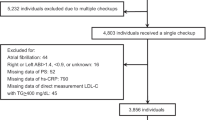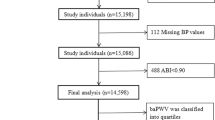Abstract
Different blood pressure (BP) indices had varying associations with carotid intima-media thickness (cIMT) and plaques in clinical practice. However, insufficient evidence has focused on this issue, especially in Chinese population. Herein we examined associations of different BP indices with cIMT and plaques cross-sectionally in a community-based atherosclerosis cohort. We qualitatively measured cIMT and plaques, and also measured central systolic blood pressure and brachial systolic blood pressure (baSBP), from which pulse pressure (PP), and second PP (PP2) were calculated. Logistic multivariate regression was used to assess the associations with BP indices and carotid artery hypertrophy (increased cIMT) and the extent of atherosclerosis (presence of plaques). Each BP index was significantly and independently associated with increased cIMT and plaques except the association of baSBP with plaques. When every two BP indices were put into one model, brachial pressure indices were associated with increased cIMT independently of central pressures, whereas the association between central pressure indices and plaque presence were stronger than those of brachial pressures. In addition, SBP indices were associated with increased cIMT independently of PP indices, whereas PP indices were more strongly related to plaques. In conclusion, central and PP indices might be associated with plaques; however, brachial and SBP indices might be associated with increased cIMT. Nevertheless, whether these BP indices predict increased cIMT and plaque progression warrants further longitudinal and laboratory studies.
This is a preview of subscription content, access via your institution
Access options
Subscribe to this journal
Receive 12 digital issues and online access to articles
$119.00 per year
only $9.92 per issue
Buy this article
- Purchase on Springer Link
- Instant access to full article PDF
Prices may be subject to local taxes which are calculated during checkout
Similar content being viewed by others
References
Yusuf S, Reddy S, Ounpuu S, Anand S . Global burden of cardiovascular diseases: part I: general considerations, the epidemiologic transition, risk factors, and impact of urbanization. Circulation 2001; 104: 2746–2753.
Xie W, Liang L, Zhao L, Shi P, Yang Y, Xie G et al. Combination of carotid intima-media thickness and plaque for better predicting risk of ischaemic cardiovascular events. Heart 2011; 97: 1326–1331.
Chambless LE, Heiss G, Folsom AR, Rosamond W, Szklo M, Sharrett AR et al. Association of coronary heart disease incidence with carotid arterial wall thickness and major risk factors: the Atherosclerosis Risk in Communities (ARIC) Study, 1987–1993. Am J Epidemiol 1997; 146: 483–494.
Bots ML, Hoes AW, Koudstaal PJ, Hofman A, Grobbee DE . Common carotid intima-media thickness and risk of stroke and myocardial infarction: the Rotterdam Study. Circulation 1997; 96: 1432–1437.
Touboul PJ, Hennerici MG, Meairs S, Adams H, Amarenco P, Bornstein N et al. Mannheim carotid intima-media thickness and plaque consensus (2004-2006-2011). Cerebrovasc Dis 2012; 34: 290–296.
Roman Mary J, Devereux Richard B, Kizer Jorge R, Lee Elisa T, Galloway James M, Ali Tauqeer et al. Central pressure more strongly relates to vascular disease and outcome than does brachial pressure: the Strong Heart Study. Hypertension 2007; 50: 197–203.
Roman Mary J, Devereux RB . Association of central and peripheral blood pressures with intermediate cardiovascular phenotypes. Hypertension 2014; 63: 1148–1153.
Benetos A, Safar M, Rudnichi A, Smulyan H, Richard J-L, Ducimetie're P et al. Pulse pressure: a predictor of long-term cardiovascular mortality in a French male population. Hypertension 1999; 30: 1410–1415.
Franklin SS, Khan SA, Wong NA, Larson MG, Levy D . Is pulse pressure useful in predicting risk for coronary heart disease? The Framingham Heart Study. Circulation 1999; 100: 354–360.
Glynn RJ, Chae CU, Guralnik JM, Taylor JO, Hennekens CH . Pulse pressure and mortality in older people. Arch Intern Med 2000; 160: 2765–2772.
Vaccarino V, Holford TR, Krumholz HM . Pulse pressure and risk for myocardial infarction and heart failure in the elderly. J Am Coll Cardiol 2000; 36: 130–138.
Domanski M, Norman J, Wolz M, Mitchell G, Pfeffer M . Cardiovascular risk assessment using pulse pressure in the First National Health and Nutrition Examination Survey (NHANES I). Hypertension 2001; 38: 793–797.
Palmieri V, Devereux RB, Holloywood J, Bella JN, Liu JE, Lee ET et al. Association of pulse pressure with cardiovascular outcome is independent of left ventricular hypertrophy and systolic dysfunction: the Strong Heart Study. J Hypertens 2006; 19: 601–607.
Cai A, Mo Y, Zhang Y, Li J, Chen J, Zhou Y et al. Relationship of pulse pressure index and carotid intima-media thickness in hypertensive adults. Clin Exp Hypertens 2014; 37: 267–270.
Odaira M, Tomiyama H, Hashimoto H, Kojima I, Matsumoto C, Yoshida M et al. Increased arterial stiffness weakens the relationship between wave reflection and the central pressure indexes in men younger than 60 years of age. Am J Hypertens 2011; 24: 881–886.
Levey AS, Stevens LA, Schmid CH, Zhang YL, Castro AF, Feldman HI et al. A new equation to estimate glomerular filtration rate. Ann Intern Med 2009; 150: 604–661.
Lorenz Matthias W, Markus Hugh S, Bots Michiel L, Rosvall Maria, Matthias Sitzer . Prediction of clinical cardiovascular events with carotid intima-media thickness: a systematic review and meta-analysis. Circulation 2007; 115: 459–467.
Spence JD, Hegele RA . Noninvasive phenotypes of atherosclerosis: similar windows but different views. Stroke 2004; 35: 649–653.
Inaba Y, Chen J, Bergmann S . Carotid plaque, compared with carotid intima-media thickness, more accurately predicts coronary artery disease events: a meta-analysis. Atherosclerosis 2012; 220: 128–133.
Rundek T, Arif H, Boden-Albala B, Elkind MS, Paik MC, Sacco RL . Carotid plaque, a subclinical precursor of vascular events: the Northern Manhattan Study. Neurology 2008; 70: 1200–1207.
Mannami T, Konishi M, Baba S, Nishi N, Terao A . Prevalence of asymptomatic carotid atherosclerotic lesions detected by high-resolution ultrasonography and its relation to cardiovascular risk factors in the general population of a Japanese city: the Suita Study. Stroke 1997; 28: 518–525.
Lefkowitz RJ, Willerson JT . Prospects for cardiovascular research. JAMA 2001; 285: 581–587.
Spence JD, Rundek T Toward clinical applications of carotid ultrasound: Intima-media thickness, plaque area, and three-dimensional phenotypes Ultrasound and Carotid Bifurcation Atherosclerosis, In: Nicolaides AE ed. Springer-Verlag: London, UK, 2012, 431–448.
Spence JD, Barnett PA, Bulman DE, Hegele RA . An approach to ascertain probands with a nontraditional risk factor for carotid atherosclerosis. Atherosclerosis 1999; 144: 429–434.
Kuo F, Gardener H, Dong C, Cabral D, Della-Morte D, Blanton SH et al. Traditional cardiovascular risk factors explain the minority of the variability in carotid plaque. Stroke 2012; 43: 1755–1760.
Pauca AL . The second peak of the radial artery pressure wave represents aortic systolic pressure in hypertensive and elderly patients. Br J Anaesth 2004; 92: 651–657.
Takazawa K, Kobayashi H, Shindo N, Tanaka N, Yamashina A . Relationship between radial and central arterial pulse wave and evaluation of central aortic pressure using the radial arterial pulse wave. Hypertens Res 2007; 30: 219–228.
Takazawa K, Kobayashi H, Kojima I, Aizawa A, Kinoh M, Sugo Y et al. Estimation of central aortic systolic pressure using late systolic inflection of radial artery pulse and its application to vasodilator therapy. J Hypertens 2012; 30: 908–916.
Ohara M, Kohara K, Tabara Y, Igase M, Miki T . Portable indices for sarcopenia are associated with pressure wave reflection and central pulse pressure: the J-SHIPP study. J Hypertens 2015; 33: 314–322.
Wang KL, Cheng HM, Chuang SY, Spurgeon HA, Ting CT, Lakatta EG et al. Central or peripheral systolic or pulse pressure: which best relates to target-organs and future mortality? J Hypertens 2009; 27: 461–467.
DeLoach SS, Appel LJ, Chen J, Joffe MM, Gadegbeku CA, Mohler ER et al. Aortic pulse pressure is associated with carotid IMT in chronic kidney disease: report from Chronic Renal Insufficiency Cohort. Am J Hypertens 2009; 22: 1235–1241.
Finn AV, Kolodgie FD, Virmani R . Correlation between carotid intimal/medial thickness and atherosclerosis: a point of view from pathology. Arterioscler Thromb Vasc Biol 2010; 30: 177–181.
Cheng HM, Sung SH, Chuang SY, Pearson A, Tufanaru C, White S et al. Diagnostic performance of a stand-alone central blood pressure monitor: application of central blood pressure in the diagnosis of high blood pressure. Am J Hypertens 2014; 27: 382–391.
Ikonomidis I, Makavos G, Lekakis J . Arterial stiffness and coronary artery disease. Curr Opin Cardiol 2015; 30: 422–431.
Author information
Authors and Affiliations
Corresponding author
Ethics declarations
Competing interests
The authors declare no conflict of interest.
Rights and permissions
About this article
Cite this article
Cheng, G., Fan, F., Zhang, Y. et al. Different associations between blood pressure indices and carotid artery damages in a community-based population of China. J Hum Hypertens 30, 750–754 (2016). https://doi.org/10.1038/jhh.2016.36
Received:
Revised:
Accepted:
Published:
Issue Date:
DOI: https://doi.org/10.1038/jhh.2016.36
This article is cited by
-
The relationship between carotid intima–media thickness and carotid plaque: a cohort study in China
Journal of Human Hypertension (2020)
-
Noninvasive central systolic blood pressure, not peripheral systolic blood pressure, independently predicts the progression of carotid intima-media thickness in a Chinese community-based population
Hypertension Research (2019)
-
Correlation between hypertension and common carotid artery intima-media thickness in rural China: a population-based study
Journal of Human Hypertension (2018)
-
Time-averaged hemoglobin values, not hemoglobin cycling, have an impact on outcomes in pediatric dialysis patients
Pediatric Nephrology (2018)
-
Associations of plasma homocysteine levels with peripheral systolic blood pressure and noninvasive central systolic blood pressure in a community-based Chinese population
Scientific Reports (2017)



